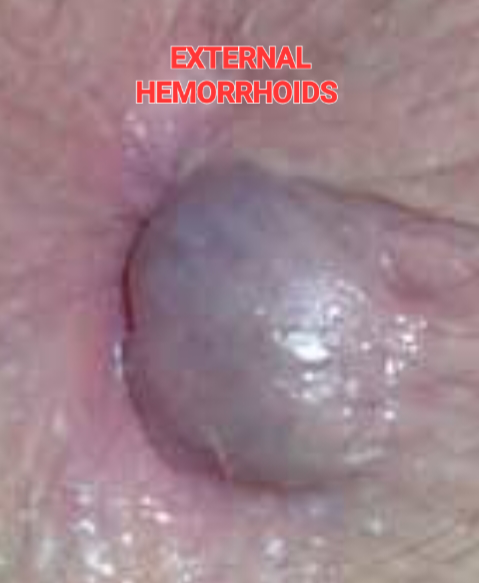Piles, commonly referred to as hemorrhoids in medical terms, are characterized by the swelling of veins and surrounding tissue within the anal canal. They are categorized into two main types, namely external and internal hemorrhoids, based on their specific location. In the case of internal hemorrhoids, they form above the dentate line inside the anal canal as a result of swelling in the internal hemorrhoidal plexus. These internal hemorrhoids are further differentiated into four grades, ranging from Grade 1 to Grade 4, depending on their size and severity. On the other hand, external hemorrhoids develop externally around the anal verge due to bleeding in the external hemorrhoidal plexus, and leading to the formation of a hematoma.
Symptoms of Piles:
The symptoms associated with piles, whether they are external or internal hemorrhoids, can manifest differently. Internal hemorrhoids, characterized by painless bleeding during bowel movements across all grades, present distinct features based on their severity. Grade 1 internal piles typically do not have a palpable mass, while in Grade 2, a mass protrude during a bowel movement before retracting afterward. Moving to Grade 3, the mass may extend during bowel movements, necessitating manual reduction, and in Grade 4, the mass tends to remain extruded. Pain in internal hemorrhoids usually occurs when they become strangulated or thrombosed. Furthermore, internal hemorrhoids are covered by mucosa and exhibit a red or blue hue.

On the other hand, external hemorrhoids are distinguished by a detectable lump at the anal verge, often firm to the touch and skin-colored with a subtle bluish tinge. Individuals with external hemorrhoids commonly experience pain and discomfort while sitting. Although bleeding is not a prevalent symptom in external piles, it may occur if they are inadvertently ruptured due to abrasion. It is important to recognize these distinctive symptoms to seek appropriate medical attention and treatment for hemorrhoids.

How piles are diagnosed?
When you schedule an appointment for a consultation with a doctor, it is common practice for the doctor to inquire about various aspects such as the onset of your symptoms and the nature of the symptoms you are experiencing. This initial questioning is essential for the doctor to gain a clear understanding of your condition. Following this, the doctor typically performs a local examination, which may include a visual inspection of the affected area, a manual examination through the rectum (per rectal digital examination), and even an anoscopy for a direct view of the anal canal. These steps are vital in order for the doctor to accurately diagnose any issues, particularly concerning instances of rectal bleeding, as not all cases of rectal bleeding are necessarily indicative of hemorrhoids.It Is highly recommended to seek medical attention promptly if you are experiencing any symptoms related to piles, as early intervention can significantly impact the prognosis. Therefore, it is advisable to consult with a specialist as soon as you notice any signs or symptoms associated with hemorrhoids to receive the best possible care and ensure optimal recovery. Remember, swift action and expert medical evaluation are key factors in effectively managing and treating conditions like hemorrhoids.
Kshar Sutra: ultimate solution for piles treatment
For centuries, the ancient practice of Kshar Sutra has been a revered tradition in India. This specialized technique involves the use of a medicated thread meticulously crafted with multiple layers of herbal medicine. The powerful herbal formulations imbue the thread with the unique ability to cut and heal simultaneously, offering a holistic approach to treatment. Furthermore, the thread Boasts antimicrobial properties that serve to reduce the risk of infection, providing an added layer of protection. Renowned for its efficacy, Kshar Sutra is widely utilized in the management of various anorectal conditions such as piles, fistula, fissure, pilonidal sinus, and other benign growths. Its unparalleled success in treating internal hemorrhoids has underscored its reputation as the premier therapy for this particular ailment.
How Kshar Sutra treatment is done in internal hemorrhoids?
Kshar sutra is a para surgical procedure that is typically performed on an outpatient basis, offering patients the convenience of not needing to stay overnight in a hospital. This treatment is conducted under local anesthesia, ensuring that the patient is comfortable throughout the procedure. Before the actual Kshar Sutra treatment, routine blood investigations are carried out as a standard protocol to assess the patient’s overall health status. In preparation for the procedure, the patient is advised to take a laxative the night before to ensure the rectum is adequately cleaned. On the day of the procedure, patients are allowed to have a light breakfast to maintain energy levels. The Kshar sutra procedure is usually conducted in a minor operating theater, where the patient is carefully positioned in the lithotomy posture on the operating table. The area is meticulously prepared, with thorough painting and draping to maintain surgical hygiene. Local anesthesia is then administered around the piles mass to ensure the patient’s comfort. The piles mass is gently held with specialized forceps, and the kshar sutra is precisely placed at the base of each piles mass. Each pile is individually ligated before being gently pushed back inside the anal canal for proper realignment. A detailed inspection is performed to check for any signs of active bleeding or complications. Once the procedure is complete, the patient is dressed appropriately and transferred to a recovery room for observation. After an hour of monitoring, the patient is discharged with guidance for post-operative care.
Kshar sutra emerges as a highly recommended treatment option for piles due to a variety of compelling reasons. Firstly, being conducted under local anesthesia significantly reduces the risk of complications associated with more invasive procedures. This technique is minimally invasive as it does not involve any cutting, resulting in minimal to no blood loss during the procedure. Moreover, the success rate of Kshar Sutra treatment is notably high, with minimal chances of recurrence, offering patients long-term relief. One of the key advantages is that hospitalization Is typically not required, making it a convenient option for individuals seeking treatment for piles. Additionally, the procedure is considered safe for individuals of any age group due to its minimal complications and gentle nature.
For individuals seeking top-notch piles treatment in India, Arogyam Piles Clinic and Research Center based in Mohali, Chandigarh, stands out as a leading center for providing effective Kshar Sutra treatment. Their team comprises highly experienced doctors who have successfully treated numerous patients, demonstrating expertise and proficiency in this advanced treatment technique. To schedule an appointment with the clinic, interested individuals can visit their official website at www.arogyampilesclinic.com or directly reach out to them at +91 96467 64444.



